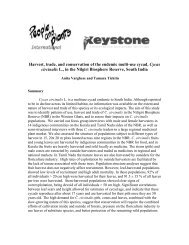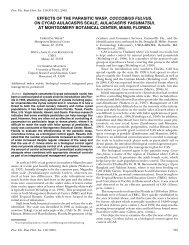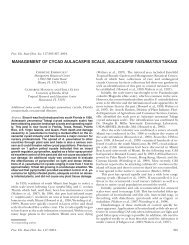Glossary of terms used in cycad systematics - Cycad Specialist Group
Glossary of terms used in cycad systematics - Cycad Specialist Group
Glossary of terms used in cycad systematics - Cycad Specialist Group
Create successful ePaper yourself
Turn your PDF publications into a flip-book with our unique Google optimized e-Paper software.
Walters & Osborne – <strong>Cycad</strong> Classification: Concepts & Recommendations, Appendix 2 7<br />
dendrogram. Generic term for any k<strong>in</strong>d <strong>of</strong> tree diagram, <strong>in</strong>clud<strong>in</strong>g cladograms, phenograms and<br />
phylograms.<br />
dentate. Hav<strong>in</strong>g sharp <strong>in</strong>dentations or teeth along the edge <strong>of</strong> a structure and perpendicular to its marg<strong>in</strong>.<br />
See also serrate.<br />
denticulate. F<strong>in</strong>ely dentate. See also serrate, serrulate.<br />
determ<strong>in</strong>ate. With growth <strong>of</strong> an axis ceas<strong>in</strong>g at a particular stage. Cf. <strong>in</strong>determ<strong>in</strong>ate.<br />
dichotomous. Branch<strong>in</strong>g <strong>in</strong>to two equal parts, as <strong>in</strong> forked branch<strong>in</strong>g <strong>of</strong> stems <strong>of</strong> Cycas elongata, leaflets<br />
<strong>of</strong> Macrozamia stenomera or megasporophyll lobes <strong>of</strong> Cycas segmentifida. Also <strong>used</strong> <strong>in</strong> reference to<br />
branch<strong>in</strong>g patterns <strong>in</strong> dendrograms.<br />
dimorphic. Hav<strong>in</strong>g two different forms. See also homomorphic, monomorphic, polymorphic.<br />
dioecious. Hav<strong>in</strong>g male and female reproductive parts on different plants. All extant <strong>cycad</strong>s are<br />
dioecious.<br />
diploid. Hav<strong>in</strong>g a pair <strong>of</strong> chromosomes <strong>of</strong> each k<strong>in</strong>d. Cf. haploid.<br />
discrim<strong>in</strong>ant analysis. Statistical technique <strong>used</strong> <strong>in</strong> separat<strong>in</strong>g discreet sets <strong>of</strong> objects.<br />
disjunct. Separated geographically, perta<strong>in</strong><strong>in</strong>g to populations <strong>of</strong> the same taxon occurr<strong>in</strong>g <strong>in</strong> more than<br />
one geographical area.<br />
distal. Furthest away from the center <strong>of</strong> a structure or, more commonly, furthest from its po<strong>in</strong>t <strong>of</strong><br />
attachment; term<strong>in</strong>al; apical. Cf. proximal.<br />
DNA. Deoxyribonucleic acid; desoxyribonucleic acid, the molecule <strong>in</strong> which an organism’s genetic<br />
def<strong>in</strong>ition is determ<strong>in</strong>ed by the sequence <strong>of</strong> nitrogenous bases project<strong>in</strong>g along a ‘backbone’ <strong>of</strong> sugar<br />
moeities l<strong>in</strong>ked by phosphodiester bonds.<br />
ecology. Study <strong>of</strong> relationships <strong>of</strong> liv<strong>in</strong>g organisms to each other and to their physical and chemical<br />
environment.<br />
ecosystem. Sum <strong>of</strong> all biological, chemical and physical components <strong>of</strong> an area and their <strong>in</strong>teraction.<br />
edaphic. Relat<strong>in</strong>g to the soil environment, e.g. soil quality, pH, etc.<br />
electrophoresis. Analytical technique <strong>in</strong> which an electrical gradient is <strong>used</strong> to separate compounds,<br />
especially prote<strong>in</strong>s, accord<strong>in</strong>g to their charge and molecular mass.<br />
elliptic. Of a two-dimensional structure that is widest near the middle but narrowed towards each<br />
rounded end. See also obovate, ovate.<br />
elongate. Lengthened or drawn out, e.g. as for the megasporophyll apical sp<strong>in</strong>es <strong>of</strong> Cycas elongata.<br />
embryo. In seeds, diploid tissue aris<strong>in</strong>g from the zygote, until the time <strong>of</strong> germ<strong>in</strong>ation.<br />
embryology. Study <strong>of</strong> the morphology and development <strong>of</strong> embryos, pollen, megagametophytes and<br />
microgametophytes.






